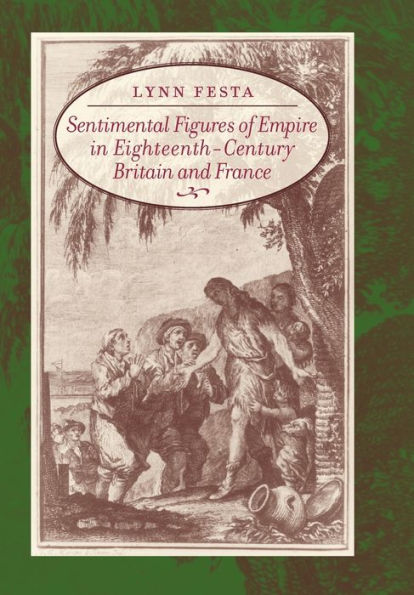

Hardcover(ANN)
-
PICK UP IN STORECheck Availability at Nearby Stores
Available within 2 business hours
Related collections and offers
Overview
Read in isolation, sentimental texts can be made to tell a simple story about the emergence of the modern psychological self. Placed in conversation with empire, however, sentimentality invites both psychological and cultural readings of the encounter between self and other. Sentimental texts, Festa claims, enabled readers to create powerful imagined relations to distant people. Yet these emotional bonds simultaneously threatened the boundaries between self and other, civilized and savage, colonizer and colonized. Festa argues that sentimental tropes and figures allowed readers to feel for others, while maintaining the particularity of the individual self. Sentimental identification thus operated as a form of differentiation as well as consolidation.
Festa contends that global reach increasingly outstripped imaginative grasp during this era. Sentimentality became an important tool for writers on empire, allowing conquest to be portrayed as commerce and scenes of violence and exploitation to be converted into displays of benevolence and pity. Above all, sentimental texts used emotion as an important form of social and cultural distinction, as the attribution of sentience and feeling helped to define who would be recognized as human.

Product Details
| ISBN-13: | 9780801884306 |
|---|---|
| Publisher: | Johns Hopkins University Press |
| Publication date: | 10/15/2006 |
| Edition description: | ANN |
| Pages: | 312 |
| Product dimensions: | 6.00(w) x 9.00(h) x 0.90(d) |
| Age Range: | 18 Years |
About the Author
Table of Contents
AcknowledgmentsIntroduction: The Great World Without1. The Distinction of Sentimental FeelingSentimental BabelHume, Smith, and the Property of FeelingFrench Sympathy and the Model of the HumanThe Sentimental Wealth of NationsRomance, Epic, and the Sentimental Rewriting of Eighteenth-Century Empire2. Sterne's SnuffboxYorick's Snuffbox and the Paradox of the Sentimental CommodityEmotions in an Age of Mechanical ReproductionTristram Shandy and the Befetish'd WordThe Sentimental Deficit and the Journal to Eliza3. Tales Told by ThingsThe People Things MakeThe Commodity's SoliloquyThinking Through ThingsSubject and Object in Olaudah Equiano's Life4. Making Humans HumanOf Price and MenDay, Cowper, Wedgwood, and the Tropes of Redundant PersonificationDiscriminating Figures in Janet Schaw's JournalPolitical Sympathies and the Sympathetic MisfireUsurpation and Empathy in Parliamentary DebatesReversible Figures5. Global Commerce in Raynal's Histoire des deux IndesCommerce as the Motor of the WorldLachrymose IntoleranceHuman InterestCoda: The Peripheral Vision of the EnlightenmentNotesWorks CitedIndexWhat People are Saying About This
Extremely well written and very persuasive in suggesting how the discourses of sympathetic identification work to reinscribe various forms of social, gender, and imperial difference. While there are numerous studies devoted to the literary construction of sentimental selfhood in the eighteenth century and a rapidly growing body of work on the genesis of the British empire, no other critic has argued so convincingly for a dialectical approach to the relationship between sentimental texts and the larger sociocultural effects of imperial designs and operations.
— Robert Markley, University of Illinois at Urbana-Champaign
Thoughtful, witty, and brimming over with insight and information, Sentimental Figures of Empire offers the best explanation I know of how and why the language of sentimentalism became the preferred idiom for both vindicating and critiquing Europeans' colonial activities. Scholars of Enlightenment philosophy, of abolitionism, of the French and British novel will all benefit from—and be moved by—this rich account of sympathy's global travels during the long eighteenth century.
— Deidre Shauna Lynch, Indiana University
Extremely well written and very persuasive in suggesting how the discourses of sympathetic identification work to reinscribe various forms of social, gender, and imperial difference. While there are numerous studies devoted to the literary construction of sentimental selfhood in the eighteenth century and a rapidly growing body of work on the genesis of the British empire, no other critic has argued so convincingly for a dialectical approach to the relationship between sentimental texts and the larger sociocultural effects of imperial designs and operations.—Robert Markley, University of Illinois at Urbana-Champaign
With considerable verve and tenacity, Lynn Festa demonstrates that the sentimental mode in the eighteenth century was inextricable from the colonial beginnings of empire. The flinty lightness of Festa’s readings cannily resembles the subtlety and style of the varied examples she deftly analyzes, from the snuffbox in Sterne’s A Sentimental Journey to the perorations in Raynal’s History of the Two Indies. By documenting how writers during the period ventriloquize ostensibly mute slaves as well as inanimate objects, Festa shows how sentimentalism challenged—and also extended—the reach of empire. By plumbing the complexity of eighteenth-century mercantilist and abolitionist discourses, this study breaks new ground in the scholarship about sentimentalism.—Srinivas Aravamudan, Duke University
Thoughtful, witty, and brimming over with insight and information, Sentimental Figures of Empire offers the best explanation I know of how and why the language of sentimentalism became the preferred idiom for both vindicating and critiquing Europeans' colonial activities. Scholars of Enlightenment philosophy, of abolitionism, of the French and British novel will all benefit from—and be moved by—this rich account of sympathy's global travels during the long eighteenth century.—Deidre Shauna Lynch, Indiana University
With considerable verve and tenacity, Lynn Festa demonstrates that the sentimental mode in the eighteenth century was inextricable from the colonial beginnings of empire. The flinty lightness of Festa’s readings cannily resembles the subtlety and style of the varied examples she deftly analyzes, from the snuffbox in Sterne’s A Sentimental Journey to the perorations in Raynal’s History of the Two Indies. By documenting how writers during the period ventriloquize ostensibly mute slaves as well as inanimate objects, Festa shows how sentimentalism challenged—and also extended—the reach of empire. By plumbing the complexity of eighteenth-century mercantilist and abolitionist discourses, this study breaks new ground in the scholarship about sentimentalism.
— Srinivas Aravamudan, Duke University
